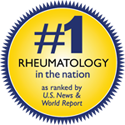
Urate lowering therapy can be very effective for reducing flares of gout, thereby preventing ongoing joint damage and deformity. Despite this efficacy, most gout patients are undertreated, leading to undue painful flares and joint damage. Non-adherence to therapy is a strong contributor to undertreatment. Here, Solomon et al (Ann Rheum Dis 2008; 67: 609) explore adherence to and barriers to urate lowering therapy in a cohort of patients receiving urate lowering therapy through a state supported pharmacy benefit program.
Methods
Subjects were enrollees in the Pennsylvania Medicare Pharmacy Assistance for the Elderly (PACE) program, designed for low-income adults age 65 years and older. New users of urate lowering medications (allopurinol, probenecid, and sulfinpyrazone) were followed for persistence of use (with those with 80% of higher persistence of use considered adherent to urate lowering therapy). The associations of patient and physician characteristics were explored in relation to adherence over time.
Results
There were 9823 subjects who initiated urate lowering therapy. Most of the subjects were female (72%), Caucasian (93%) and had a mean age of 79 years. A minority were receiving concomitant NSAIDs, colchicines, or glucocorticoids. Acute gout was diagnosed in 13% and only 1% were diagnosed with tophaceouos gout. The most frequent starting dose of allopurinol was between 100-200 mg/day, and did not differ by prescriber (specialist vs. non-specialist). Only about half of patients received maximum doses of 300 mg per day or higher.
The average percentage of days on drug was 54% of available days, with 64% of subjects designated as non-adherent. These proportions were similar when analyses were restricted to subjects with acute vs. chronic gout. Factors associated with non-adherence included younger age, African-American race, fewer acute hospitalizations, fewer comorbid conditions, no-prior colchicines therapy, and lack of tophi. Receiving first prescription of urate lowering therapy from a specialist was also associated with longer persistence of therapy.
Conclusions
Poor adherence and extended discontinuation were common with urate lowering therapy in this cohort of older gout patients receiving indigent medication assistance.
Editorial Comment
These interesting results may help to identify gout patients at greatest risk for non-adherence. The finding that patients with less severe symptoms are the least adherent is not quite surprising, since patients may be reluctant to stick to a daily medication when symptoms are intermittent and there are no noticeable signs of gout between attacks. It is these patients who are at risk of progressively more frequent attacks if urate therapy is not maintained. Although the study presented here is the largest of its kind to date, there may be issues of external validity given that the patient profile is atypical of many that will be encountered in clinical practice (i.e. the patients population was mostly indigent elderly white females and not middle aged males of middle income of higher). Thus, it is unclear from this study whether predictors of non-adherence would correlate as strongly if a different patient population were studied.

